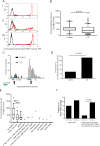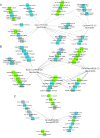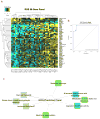Clinical and Genomic Correlates of Neutrophil Reactive Oxygen Species Production in Pediatric Patients With Crohn's Disease
- PMID: 29454792
- PMCID: PMC5985211
- DOI: 10.1053/j.gastro.2018.02.016
Clinical and Genomic Correlates of Neutrophil Reactive Oxygen Species Production in Pediatric Patients With Crohn's Disease
Abstract
Background & aims: Individuals with monogenic disorders of phagocyte function develop chronic colitis that resembles Crohn's disease (CD). We tested for associations between mutations in genes encoding reduced nicotinamide adenine dinucleotide phosphate (NADPH) oxidases, neutrophil function, and phenotypes of CD in pediatric patients.
Methods: We performed whole-exome sequence analysis to identify mutations in genes encoding NADPH oxidases (such as CYBA, CYBB, NCF1, NCF2, NCF4, RAC1, and RAC2) using DNA from 543 pediatric patients with inflammatory bowel diseases. Blood samples were collected from an additional 129 pediatric patients with CD and 26 children without IBD (controls); we performed assays for neutrophil activation, reactive oxygen species (ROS) production, and bacteria uptake and killing. Whole-exome sequence analysis was performed using DNA from 46 of the children with CD to examine associations with NADPH gene mutations; RNA sequence analyses were performed using blood cells from 46 children with CD to test for variations in neutrophil gene expression associated with ROS production.
Results: We identified 26 missense mutations in CYBA, CYBB, NCF1, NCF2, and NCF4. Patients with CD who carried mutations in these genes were 3-fold more likely to have perianal disease (P = .0008) and stricturing complications (P = .002) than children with CD without these mutations. Among patients with CD with none of these mutations, 9% had undergone abdominal surgery; among patients with mutations in these NADPH oxidase genes, 31% had undergone abdominal surgery (P = .0004). A higher proportion of neutrophils from children with CD had low ROS production (47%) than from controls (15%) among the 129 patients tested for ROS (P = .002). Minor alleles of the NADPH genes were detected in 7% of children with CD whose neutrophils produced normal levels of ROS vs 38% of children whose neutrophils produced low levels of ROS (P = .009). Neutrophils that produced low levels of ROS had specific alterations in genes that regulate glucose metabolism and antimicrobial responses.
Conclusions: We identified missense mutations in genes that encode NADPH oxidases in children with CD; these were associated with a more aggressive disease course and reduced ROS production by neutrophils from the patients.
Keywords: Genetic Variant; IBD; Neutrophil Oxidative Burst; WES.
Copyright © 2018 AGA Institute. Published by Elsevier Inc. All rights reserved.
Conflict of interest statement
Conflict of interest statement: The authors have no financial arrangement(s) with a company whose product figures prominently in the submitted manuscript or with a company making a competing product. The remaining authors have nothing to declare.
Competing Interest: None to declare
Figures




Similar articles
-
NADPH oxidase complex and IBD candidate gene studies: identification of a rare variant in NCF2 that results in reduced binding to RAC2.Gut. 2012 Jul;61(7):1028-35. doi: 10.1136/gutjnl-2011-300078. Epub 2011 Sep 7. Gut. 2012. PMID: 21900546 Free PMC article.
-
Genetic and Transcriptomic Variation Linked to Neutrophil Granulocyte-Macrophage Colony-Stimulating Factor Signaling in Pediatric Crohn's Disease.Inflamm Bowel Dis. 2019 Feb 21;25(3):547-560. doi: 10.1093/ibd/izy265. Inflamm Bowel Dis. 2019. PMID: 30124884 Free PMC article.
-
Methylation of selected CpG islands involved in the transcription of myeloperoxidase and superoxide dismutase 2 in neutrophils of periparturient and mid-lactation cows.J Dairy Sci. 2019 Aug;102(8):7421-7434. doi: 10.3168/jds.2018-16027. Epub 2019 Jun 6. J Dairy Sci. 2019. PMID: 31178179
-
Genetic disorders coupled to ROS deficiency.Redox Biol. 2015 Dec;6:135-156. doi: 10.1016/j.redox.2015.07.009. Epub 2015 Jul 17. Redox Biol. 2015. PMID: 26210446 Free PMC article. Review.
-
The roles of NADPH oxidase in modulating neutrophil effector responses.Mol Oral Microbiol. 2019 Apr;34(2):27-38. doi: 10.1111/omi.12252. Epub 2019 Feb 7. Mol Oral Microbiol. 2019. PMID: 30632295 Free PMC article. Review.
Cited by
-
Neutrophils: from IBD to the gut microbiota.Nat Rev Gastroenterol Hepatol. 2024 Mar;21(3):184-197. doi: 10.1038/s41575-023-00871-3. Epub 2023 Dec 18. Nat Rev Gastroenterol Hepatol. 2024. PMID: 38110547 Review.
-
The role of gut microbiota in intestinal disease: from an oxidative stress perspective.Front Microbiol. 2024 Feb 14;15:1328324. doi: 10.3389/fmicb.2024.1328324. eCollection 2024. Front Microbiol. 2024. PMID: 38419631 Free PMC article. Review.
-
NCF4 attenuates colorectal cancer progression by modulating inflammasome activation and immune surveillance.Nat Commun. 2024 Jun 17;15(1):5170. doi: 10.1038/s41467-024-49549-7. Nat Commun. 2024. PMID: 38886341 Free PMC article.
-
Development and Experimental Validation of Machine Learning-Based Disulfidptosis-Related Ferroptosis Biomarkers in Inflammatory Bowel Disease.Genes (Basel). 2025 Apr 27;16(5):496. doi: 10.3390/genes16050496. Genes (Basel). 2025. PMID: 40428318 Free PMC article.
-
Host-pathobiont interactions in Crohn's disease.Nat Rev Gastroenterol Hepatol. 2025 Jun;22(6):395-414. doi: 10.1038/s41575-024-00997-y. Epub 2024 Oct 24. Nat Rev Gastroenterol Hepatol. 2025. PMID: 39448837 Review.
References
-
- Damen GM, van Krieken JH, Hoppenreijs E, et al. Overlap, common features, and essential differences in pediatric granulomatous inflammatory bowel disease. J Pediatr Gastroenterol Nutr. 2010;51:690–7. - PubMed
-
- Marciano BE, Rosenzweig SD, Kleiner DE, et al. Gastrointestinal involvement in chronic granulomatous disease. Pediatrics. 2004;114:462–8. - PubMed
-
- Marks DJ, Miyagi K, Rahman FZ, et al. Inflammatory bowel disease in CGD reproduces the clinicopathological features of Crohn's disease. Am J Gastroenterol. 2009;104:117–24. - PubMed
Publication types
MeSH terms
Substances
Grants and funding
LinkOut - more resources
Full Text Sources
Other Literature Sources
Medical
Research Materials
Miscellaneous

